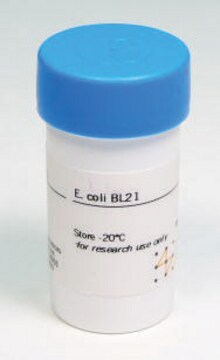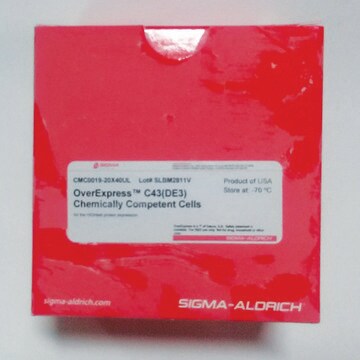CMC0016
BL21(DE3) Electrocompetent Cells
Escherichia coli, rod shaped
Synonyme(s) :
BL21 strain
About This Item
Produits recommandés
product name
BL21(DE3) Electrocompetent Cells, for protein expression
Source biologique
Escherichia coli
Qualité
for molecular biology
Mode de croissance
adherent or suspension
Morphologie
rod shaped
Technique(s)
microbiological culture: suitable
Transformation cellulaire
competent cell type: electrocompetent
transformation efficiency: ≥5 × 109 cfu/μg
Conditions d'expédition
dry ice
Température de stockage
−70°C
Description générale
Cloning efficiencies are increased 25-1,000 fold relative to other preparations of BL21 cells, which is essential for construction of complex expression libraries.
Genotype
F – ompT hsdSB (rB- mB-) gal dcm (DE3)
Caractéristiques et avantages
Composants
- BL21(DE3) electrocompetent cells
- pUC 19 transformation control DNA
- recovery medium for expression
Produit(s) apparenté(s)
Code de la classe de stockage
10 - Combustible liquids
Certificats d'analyse (COA)
Recherchez un Certificats d'analyse (COA) en saisissant le numéro de lot du produit. Les numéros de lot figurent sur l'étiquette du produit après les mots "Lot" ou "Batch".
Déjà en possession de ce produit ?
Retrouvez la documentation relative aux produits que vous avez récemment achetés dans la Bibliothèque de documents.
Protocoles
BL21(DE3) Electrocompetent Cells are provided in 25 μL aliquots, sufficient for one reaction. Transformation is carried out in a 0.1 cm gap cuvette. Optimal settings for electroporation are listed in the table below. Note that alternate settings result in transformation efficienes about 20-50% lower. Typical time constants are 3.5 to 4.5 msec.
Notre équipe de scientifiques dispose d'une expérience dans tous les secteurs de la recherche, notamment en sciences de la vie, science des matériaux, synthèse chimique, chromatographie, analyse et dans de nombreux autres domaines..
Contacter notre Service technique





